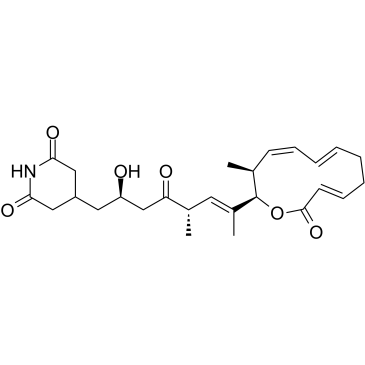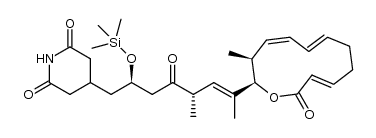Lactimidomycin
Modify Date: 2025-08-25 12:32:23

Lactimidomycin structure
|
Common Name | Lactimidomycin | ||
|---|---|---|---|---|
| CAS Number | 134869-15-1 | Molecular Weight | 457.55900 | |
| Density | 1.115g/cm3 | Boiling Point | 704.6ºC at 760mmHg | |
| Molecular Formula | C26H35NO6 | Melting Point | N/A | |
| MSDS | N/A | Flash Point | 379.9ºC | |
Use of LactimidomycinLactimidomycin is a glutarimide-containing compound isolated from Streptomyces. Lactimidomycin is a potent inhibitor of eukaryotic translation elongation. Lactimidomycin has a potent antiproliferative effect on tumor cell lines and selectively inhibit protein translation. Lactimidomycin inhibits protein synthesis with an IC50 value of 37.82 nM. Lactimidomycin is also a potent and non-toxic inhibitor of dengue virus 2 and other RNA viruses. Anticancer and antiviral activities[1][2]. |
| Name | 4-[(Z)-2-hydroxy-5-methyl-7-[(4Z,6Z,10Z)-3-methyl-12-oxo-1-oxacyclododeca-4,6,10-trien-2-yl]-4-oxooct-6-enyl]piperidine-2,6-dione |
|---|---|
| Synonym | More Synonyms |
| Description | Lactimidomycin is a glutarimide-containing compound isolated from Streptomyces. Lactimidomycin is a potent inhibitor of eukaryotic translation elongation. Lactimidomycin has a potent antiproliferative effect on tumor cell lines and selectively inhibit protein translation. Lactimidomycin inhibits protein synthesis with an IC50 value of 37.82 nM. Lactimidomycin is also a potent and non-toxic inhibitor of dengue virus 2 and other RNA viruses. Anticancer and antiviral activities[1][2]. |
|---|---|
| Related Catalog | |
| Target |
Eukaryotic translation elongation[1] Dengue virus 2 and other RNA viruses[2] |
| In Vitro | Lactimidomycin (0.01-100 nM; 24 hours; Hs 579T, HCC 1937, HCC 1395, HCC 2218, BT 474, MCF 7, MDA MB231 cells and MCF 10A) treatment inhibits cell growth with IC50 concentrations in the low nanomolar range, but higher doses are necessary to inhibit growth of the non-tumorigenic breast cell line MCF10A[1]. Lactimidomycin induces a clear dose-responsive inhibition of DENV2 infectious particle production with an EC90 value of 0.4 μM. No measurable decrease in cell viability was detected at concentrations up to 12.5 µM[2]. Lactimidomycin is a potent inhibitor of DENV2 and Lactimidomycin's inhibition of DENV2 translation leads to reduced production of newly infectious particles. Lactimidomycin may protect cells from viral cytopathic effects including apoptosis, likely through inhibition of virus protein production and replication[2]. Cell Proliferation Assay[1] Cell Line: Hs 579T, HCC 1937, HCC 1395, HCC 2218, BT 474, MCF 7, MDA MB231 cells and MCF 10A Concentration: 0.01-100 nM Incubation Time: 24 hours Result: Inhibited cell growth with IC50 concentrations in the low nanomolar range. |
| In Vivo | Lactimidomycin (0.6 mg/kg; intraperitoneal injection; daily; for one month; female nude mice) treatment has an appreciable effect on tumor growth in nude mice[1]. Animal Model: Female nude mice (6-8 week old) with MDA MB 231 cells[1] Dosage: 0.6 mg/kg Administration: Intraperitoneal injection; daily; for one month Result: Had an appreciable effect on tumor growth in vivo. |
| References |
| Density | 1.115g/cm3 |
|---|---|
| Boiling Point | 704.6ºC at 760mmHg |
| Molecular Formula | C26H35NO6 |
| Molecular Weight | 457.55900 |
| Flash Point | 379.9ºC |
| Exact Mass | 457.24600 |
| PSA | 113.26000 |
| LogP | 3.61800 |
| Vapour Pressure | 6.04E-23mmHg at 25°C |
| Index of Refraction | 1.514 |
| InChIKey | OYOKHBHOTQDIPM-BRHOHSSQSA-N |
| SMILES | CC(=CC(C)C(=O)CC(O)CC1CC(=O)NC(=O)C1)C1OC(=O)C=CCCC=CC=CC1C |
| lactimidomycin |
| 2,6-Piperidinedione,4-(2-hydroxy-5-methyl-7-(3-methyl-12oxooxacyclododeca-4,6,10-trien-2-yl)-4-oxo-6-octenyl) |
| lactidomycin |
 CAS#:1440545-78-7
CAS#:1440545-78-7 CAS#:1440545-74-3
CAS#:1440545-74-3 CAS#:1440545-63-0
CAS#:1440545-63-0![(3E,7E,9Z,11S,12R)-12-[(1E,3S,4R)-4-hydroxy-1,3-dimethyl-1-pentenyl]-11-methyloxacyclododeca-3,7,9-trien-2-one Structure](https://image.chemsrc.com/caspic/077/1247085-84-2.png) CAS#:1247085-84-2
CAS#:1247085-84-2